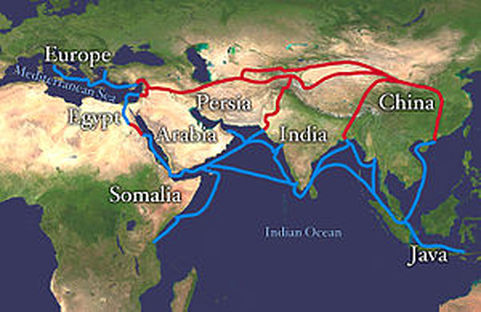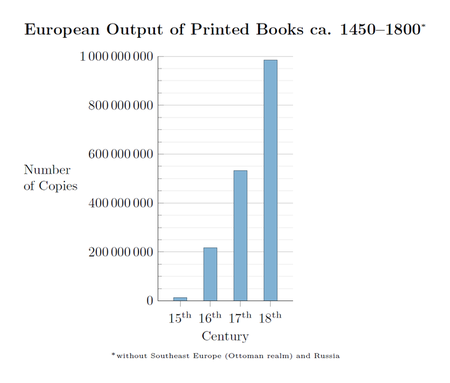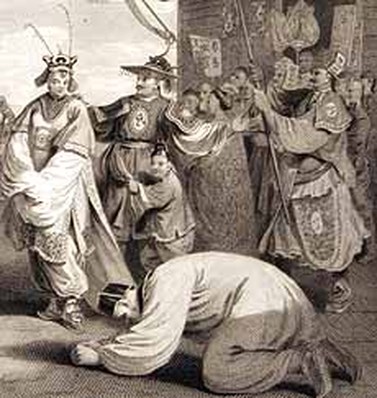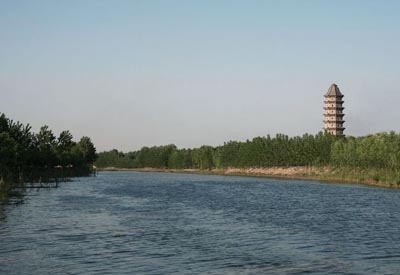Basic Gist
Neil Heberer, Victor Kang, Ashley Leppek, Avery McLeod, and Svetlana Marchionna
Global Trade Routes

The Silk Road is outlined in red, while the Indian Sea Route is outlined in blue.
The Silk Road and the Indian Sea routes began around 200 B.C with the development of silk trade throughout Eurasia, mainly the Mediterranean and China, while the Trans-Saharan trade route began very early, dating back to ancient Egypt, but was made much more efficient with the introduction of the camel in the third century. The Silk Road and the Indian Sea route played a large role throughout Eurasia, connecting the Mediterranean and East Asian ends. The Indian Sea route however, was focused more on the Southern portion of Asia and the Eastern coast of Africa. The Trans-Saharan trade route existed largely in central Africa, connecting the East and West ends. Many goods were passed on through both trade routes such as spices, jewels, pottery, meats, furs, and silk, which was the most prominently traded good on the Silk Road and Indian Trade Route because of the extreme desire that Europe had at the time. The Trans-Saharan trade route was prominently known for the trade of gold and salt mined from the salt rich dunes of Bilma, but also provided essential goods for people throughout Africa, such as food and water from oases along the path.
Luxury GoodsGoods on the Silk road generally moved from east to west, especially with the transportation of silk itself. It was the main commodity on this route, and due to its light weight, compactness, high price and demand, it increased trade between people. Near the beginning of the Silk Road, the Chinese received expensive horses, which only further contributed to the growth of the trade route as the horses provided a more efficient way to travel. Grape seeds were also crucial in the initial stages of development, as the demand was high in China to make wine. It was not until later that they realized they could make wine from rice and other berries, which were exported for high costs to foreign nations. Chinese china was also valued at a high prices. The craftsmanship in making thin porcelain bowls and pots, with exotic designs, appealed to European markets. India was infamous for their fabrics and wide range of spices and ivory. Eastern Europe held furs, skins, and cattle, which were absent in Asia. Iran especially, held silver products that were costly. Overall, each nation had its own luxury goods that foreigners desired, which lead to a general increase in trade. They helped facilitate the early stages of development of these routes.
|
Technologies and Commercial Practices

After the printing press was developed, the amount of books exploded in Europe.
The trade routes were not only extremely important because they allowed for the increased growth of nations involved, but also because they facilitated the spread of ideas and innovations which raised the standard of living for denizens of the civilization. One example of this was the invention of movable print in China, which later spread to the Holy Roman Empire and lead to the development of the printing press. The printing press was an extremely important invention to Europe at the time, because it allowed for the mass production of the bible, increasing the grasp Christianity held on the European civilizations. Another key influence that came out of China was the development of a paper money and credit system. Revolutionary to the Western world, the idea of credit and a system of money backed by the government allowed for the increased wealth of Chinese merchants. Eventually, the Europeans gained the government stability to attempt to copy the idea of paper money, which is still used in our society today. Similar to trucks today, camels in the Trans-Saharan trade route were the driving force for large scale trade in Africa. The ideas of domestication were spread throughout the trade route when traders recognized the utility that the camels provided them, allowing them to travel long distances and carry large amounts. The spread of ideas and commercial practices through trade routes were extremely important to early civilizations because without their spread and interaction empires there would be little innovation which would have promoted stagnant growth in the inhabitants' standards of living.
State PracticesGovernments of civilizations involved in the trade routes often times facilitated the growth of trade because of the wealth that could be brought in. The most prosperous empires were the ones that controlled and manipulated the trade routes. For the trade routes to work, secure governments and states had to maintain an agreement to maintain the honest trade. In the Islamic religion, the Quran was very favorable to merchants, which increased trade in that region. The Quran required fair and honest business practices, and it trusted merchants because Muhammad himself was one. With the government being intertwined with Islam, the Middle East was huge on trading, also considering they were the middle man for Europe and Asia. Muslim countries linked the continent, and the Hajj brought the Muslims together, so the Hajj became associated with trade and exchange. To facilitate more efficient trade in China, the government established a paper money and common currency system. By having paper money, merchants would be safer while traveling because of the lessened risk of robbery that would be seen with carrying a sack of gold. Also, the building of canals and complex road systems allowed for easier trade and access to different areas. An example is the Grand Canal in China, which connected the north and south, thus allowing trade to occur inside the empire. The complex waterways in China led to cheaper transportation, which led to a more prosperous empire. Facilitated by the state, the Romans had a complex road system that led to increased communication, military mobility, and trade. The roads spanned about 400,000 kilometers, connecting the entire Roman empire. By having public works, such as complex roads and canals, the trade within the empire can increase, thus allowing the empire to prosper.
|
Chinese Tribute SystemThe Chinese Tribute system was based on the belief that China was the center of the world, and the surrounding people were barbarians. The educated people in China saw the state as superior, and they did not need outside help, but the barbarians needed China's wealth and wisdom. Under the pretense of making these barbarians "civilized Chinese", they were willing to all access to them under certain conditions. This tribute system was composed of rules and practices that non Chinese governments had to acknowledge their subordination and China's superiority. Those that sought access to China had to perform the kowtow, and then the Chinese emperor would grant permission for them to trade with China. The Chinese would also present them with gifts, which were usually worth more than the tribute they had offered. With this system, the government could keep tabs on the nomads, and Korea, Vietnam, Tibet, and Japan also participated in this exchange. By allowing other civilizations to have access to China's rich markets, the spread of goods, ideas, and technology were exchanged, thus raising everyone's standard of living.
|
Citations
No Author. "Silk Road." Wikipedia. Wikimedia Foundation, 19 Dec. 2012. Web. 20 Dec. 2012.
No Author. "Transmission of Technology." Transmission of Technology. Monkey Tree, n.d. Web. 20 Dec. 2012.
No Author. "Trans-Saharan Trade." Wikipedia. Wikimedia Foundation, 19 Dec. 2012. Web. 20 Dec. 2012.
Strayer, Robert W. Ways of the World: a Brief Global History with Sources. Boston: Bedford/St Martin's, 2010. Print.
No Author. "Transmission of Technology." Transmission of Technology. Monkey Tree, n.d. Web. 20 Dec. 2012.
No Author. "Trans-Saharan Trade." Wikipedia. Wikimedia Foundation, 19 Dec. 2012. Web. 20 Dec. 2012.
Strayer, Robert W. Ways of the World: a Brief Global History with Sources. Boston: Bedford/St Martin's, 2010. Print.




